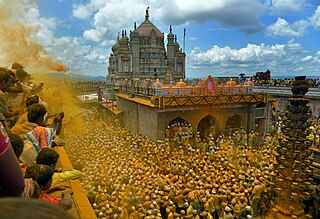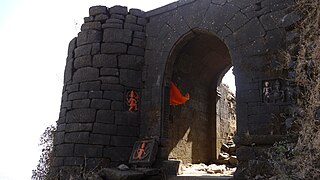Related Research Articles
The Maratha caste is composed of 96 clans, originally formed in the earlier centuries from the amalgamation of families from the peasant (Kunbi), shepherd (Dhangar), blacksmith (Lohar), carpenter (Sutar), Bhandari, Thakar and Koli castes in Maharashtra. Many of them took to military service in the 16th century for the Deccan sultanates or the Mughals. Later in the 17th and 18th centuries, they served in the armies of the Maratha Empire, founded by Shivaji, a Maratha Kunbi by caste. Many Marathas were granted hereditary fiefs by the Sultanates, and Mughals for their service.

Dalit, also some of them previously known as untouchables, is the lowest stratum of the castes in the Indian subcontinent. Dalits were excluded from the four-fold varna of the caste hierarchy and were seen as forming a fifth varna, also known by the name of Panchama. Several scholars have drawn parallels between Dalits and the Burakumin of Japan, the Baekjeong of Korea, the Hukou system of China and the peasant class of the medieval European Feudal system.

Palwankar Baloo was an Indian cricketer and political activist. In 1896, he was selected by Parmanandas Jivandas Hindu Gymkhana and played in the Bombay Quadrangular tournaments. He was employed by the Bombay Berar and Central Indian Railways, and also played for the latter's corporate cricket team. He played in the all-Indian team led by the Maharaja of Patiala during their tour of England in 1911 where Baloo's outstanding performance was praised.

Kunbi is a generic term applied to several castes of traditional farmers in Western India. These include the Dhonoje, Ghatole, Masaram, Hindre, Jadav, Jhare, Khaire, Lewa, Lonare and Tirole communities of Vidarbha. The communities are largely found in the state of Maharashtra but also exist in the states of Madhya Pradesh, Gujarat, Karnataka, Kerala and Goa. Kunbis are included among the Other Backward Classes (OBC) in Maharashtra.
The Patil is an Indian last name and a title or surname. The female variant of the title is Patlin or Patlinbai, and is also used to describe the wife of a Patil.
The Dhangars are a herding caste of people found in the Indian states of Maharashtra, Karnataka, Goa, Madhya Pradesh and Uttar Pradesh. They are referred as Gadariya in Uttar Pradesh, Kuruba & Hattikara in Karnataka, Gavli in southern Maharashtra, Goa and northern Karnataka, Golla in Andhra Pradesh and Karnataka and Ahir in northern Maharashtra. Some Gavlis live in forested hill tracts of India's Western Ghats. Gavli, also known as Dange or Mhaske, and Ahir are a sub-caste of Dhangar. However, there are many distinct Gavli castes in Maharashtra and Dhangar Gavli is one of them.
The Marathi people or Marathis are an Indo-Aryan ethnolinguistic group who are indigenous to Maharashtra in western India. They natively speak Marathi, an Indo-Aryan language. Maharashtra was formed as a Marathi-speaking state of India in 1960, as part of a nationwide linguistic reorganisation of the Indian states. The term "Maratha" is generally used by historians to refer to all Marathi-speaking peoples, irrespective of their caste; however, now it may refer to a Maharashtrian caste known as the Maratha.
Ravidassia or the Ravidas Panth is a religion based on the teachings of Guru Ravidas. It was considered a sect within Sikhism until 2009. However, some Ravidassias continue to maintain Sikh religious pratices, including the reverence of the Guru Granth Sahib as their focal religious text, wearing Sikh articles of faith (5Ks), and appending Singh or Kaur to their names.
The caste system in Goa consists of various Jātis or sub-castes found among Hindus belonging to the four varnas, as well as those outside of them. A variation of the traditional Hindu caste system was also retained by the Goan Catholic community.

Jejuri is a city and a municipal council in the Pune district of Maharashtra, India. Khandoba Mandir is an important Hindu temple to the Hindu Lord Khandoba, one of the most visited tirtha in Maharashtra.
The Ramdasia were historically a Sikh, Hindu sub-group that originated from the caste of leather tanners and shoemakers known as Chamar.

Ravidas or Raidas (1267–1335) was an Indian mystic poet-saint of the Bhakti movement during the 15th to 16th century CE. Venerated as a guru in the modern regions of Uttar Pradesh, Bihar, Rajasthan, Gujarat, Maharashtra, Madhya Pradesh, Punjab, and Haryana, he was a poet, social reformer and spiritual figure.
Mavala was a name used for people of the hilly Maval region west of the present day Indian city of Pune. It was in the Maval that the 17th century Marathi leader, Shivaji, first established his power base that later developed into the Maratha kingdom.The inhabitants of this hilly region who formed his guerrilla forces and raiding parties were known as mavale.The mavala soldiers were expert footmen and excelled in mountain warfare.The infantry was considered the backbone of Shivaji's power, and according to Sabhasad Bakhar, which chronicled Shivaji's life, the Mavale and Hasham infantry of Shivaji had 100,000 men.

Talhan is a village in Jalandhar district, near the Jalandhar Cantonment, in Punjab, India.
Kamble is a Marathi Indian surname commonly used by communities residing in Maharashtra. The word "kamble" is literally translated as "cotton blankets" and could very well be derived from it; though there also existed clan, namely Sonkamble, and this could be its derivation, too.
Gavli, Gawli or Gavali is a Hindu caste found in the Indian states of Maharashtra and Madhya pradesh. They a part of the Yadav community.
Gaekwad is a surname native to the Indian state of Maharashtra. The surname is found among the Marathas, Kolis and in Scheduled castes. It is also a common surname among Bharadis, Dhor, and Mahar communities of Maharashtra.

The Pattikar, or Patekar, Pattekar and Patikar is a clan of Koli caste found in the Indian state of Maharashtra and neighbouring Territories. Pattikar Kolis of Maval region were hereditary subedars in Maratha Army.

The Vanchit Bahujan Aaghadi is an Indian political party founded by Prakash Ambedkar on 20 March 2018. The party is primarily based in Maharashtra state in India.

Naik Govind Rao Khare was the Subedar of the hill fort Ratangarh under Peshwa government in the Maratha Empire. He was born in a farming family of Maharashtra. Khare was a revolutionary of the Indian independence movement who took up arms against the British rule in Maharashtra and declared the end of British rule. he was chief of the Kolis of Khare (Khade) clan and belong to the Mahadev koli family and led the rebellion from 1819 to 1830. his family was chief of the four villages and was tributary to peshwa and enjoying the Deshmukhi.
References
- ↑ Sharma, C. L. (1996). Social Mobility Among Scheduled Castes: An Empirical Study in an Indian State. M.D. Publications Pvt. Ltd. ISBN 978-81-7533-015-3.
- ↑ Nadkarni, M. V. (18 June 2019). Socio-Economic Change and the Broad-Basing Process in India. Taylor & Francis. ISBN 978-1-000-08477-1.
- ↑ Deshpande, Arvind M. (1987). John Briggs in Maharashtra: A Study of District Administration Under Early British Rule. New Delhi, India: Mittal Publications. pp. 127: The Chambhar or cobbler was found only in the larger villages. They held almost no rent-free land. Their total holding of rent free land in Khandesh was only 14 bighas. They had grain perquisites at the rate of the claim of the Sutar.
- ↑ Patil, S., 2020. Hegemonic Past: Exclusion of Subaltern Histories in NCERT Textbooks. ANTYAJAA: Indian Journal of Women and Social Change, 5(1), pp.9-21.
- ↑ Sinha, Surajit (1993). Anthropology of Weaker Sections. Concept Publishing Company. p. 311. ISBN 978-81-7022-491-4.
In the village the Beldar, Jain, Koli-Mahadeo, Lingayat, Chambhar, Muslim, and Panchal families are landless and among them the Jain, Koli-Mahadeo, Lingayat, and Panchal families and one Muslim are immigrants. Except these immigrants, one Brahman family, two Mali families, a few Maratha families, one Sonar, one Dhangar and one Teli are also immigrants. The head of the Jain, Koli-Mahadeo, Lingayat, Panchal, Brahman, one Mali and Maratha immigrant families are school teachers, another Mali is a village doctor, one Muslim is a forest rounder, one Maratha is a veterinary doctor and one Dhangar is an attendant in the veterinary hospital in the village. These employees are not considered as poor villagers because, they are having landed property at their native places. Formerly, the Beldar family was moving from one village to another wherever they used to get traditional jobs. In this village this family has settled for the last six years. And they get job from the villagers every month. But by this income they cannot maintain their family properly. The Muslim and the Chambhar are living in this village for generations together but they are not having cultivable land. The Muslim are traditionally butchers and get balut (annual payment) from the villagers for their job. They are also the agricultural labourers in this village. Through these two sources of income they cannot maintain their family properly and are passing days under hardships. These three Muslim families come under poorer section in the village. The Chambhar also are not having cultivable land in the village. They are still practicing their traditional occupation i.e., making new shoes or repairing the old ones. For performing traditional jobs in the village they get balut per year from the villagers. They also work as farm servants to the landowning cultivators in the village and perform their traditional jobs outside the village. Whatever they earn through traditional occupation and agricultural labour, is not sufficient for them to maintain their families. They are very poor in the village.
- ↑ Waghmare, B.S., 2009. Political Inequality Among Dalits: A Case of Maharashtra. Voice of Dalit, 2(2), pp.177-200.
- ↑ Sadangi, Himansu Charan (2008). Emancipation of Dalits and Freedom Struggle. Gyan Publishing House. ISBN 978-81-8205-481-3.
- ↑ DH News Service (13 January 2018). "The rising Dalit anger". Deccan Herald. Retrieved 20 May 2020.
- ↑ Srinivasalu Reddy, B. S. (21 November 2011). "Dalit Inc gets leg up from Milind Kamble". India Today. Retrieved 20 May 2020.
- ↑ Guha, Ramachandra (2012), Mills, James (ed.), "'The Moral that can be Safely Drawn from the Hindus' Magnificent Victory': Cricket, Caste and the Palwankar Brothers", Subaltern Sports: Politics and Sport in South Asia, Anthem Press, pp. 83–106, doi:10.7135/upo9781843317609.005, ISBN 978-1-84331-760-9
- ↑ "India's first Dalit cricketer Palwankar Baloo fought against caste barriers on the field and off it". Hindustan Times. 16 September 2018. Retrieved 20 May 2020.
- ↑ "The 'Untouchable' Cricketer Who Challenged the British & His Fellow Countrymen". The Better India. 18 September 2018. Archived from the original on 4 June 2020. Retrieved 20 May 2020.
- ↑ Bytes, Corporate (4 May 2017). "Ashok Khade, Son of a Cobbler Now Owns a Firm with Rs 500 Cr Turnover". Corporate Bytes. Retrieved 20 May 2020.